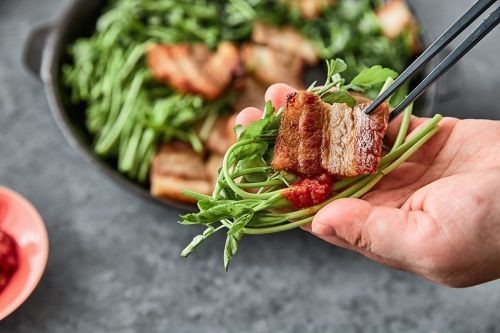While #StayAtHome challenges have been trending around the world, perhaps one of the most challenging tasks at a time like this is preparing three meals a day at home.
In response to the call to stay at home, people are flocking to online food delivery platforms, purchasing ready-to-eat foods.
Orders on grocery delivery platform Market Kurly have skyrocketed in recent weeks. Market Kurly offers a wide range of groceries and merchandise for delivery by 7 a.m. the next day for orders placed before 11 p.m.
According to app retail data service WiseApp/WiseRetail, Market Kurly is estimated to have recorded 60.4 billion won ($51.9 million) in sales in February, marking a 40 percent increase from January.
In February, Market Kurly deliveries were delayed and listed products sold out just as soon as they were stocked, as the company saw a sudden surge in users.
Other dawn delivery services have experienced similar situations, including Hello Nature, SSG and Coupang Rocketfresh.
“The idea of shopping for groceries at the supermarket is uncomfortable, with all the shopping carts, customers lining up and everything. In recent weeks, I have been ordering groceries through mobile apps,” said Shin Yeon-hee, a working mom in her 30s in Seoul.
“Ordering groceries through mobile apps is a bit expensive. But as I have young children, going out is not an option for me. I would not want to risk it,” Shin said, adding that the delivery apps offer a wider variety of produce and merchandise compared to local supermarkets.
Sales of ready-to-eat foods have been strong, too. According to Market Kurly, ready-to-eat products and cooking kits for children were popular in February and March.
From Feb. 19 to March 25, retail giant E-mart’s home meal replacement brand Peacock recorded a 26.3 percent increase in sales compared to the same period last year.
Peacock produces diverse HMR products from classic Korean dishes, ranging from cheonggukjang jjigae, or rich soybean paste stew, to daechanggui, or the grilled large intestine of cow.
On SSG, retail mogul Shinsegae’s online retailer, sales of HMR products increased by 695 percent in the past month compared to the same period last year.
Most HMR products require less than 10 minutes of cooking time, and have simple, easy-to-follow instructions. As the ingredients are already prepared for cooking, they can save a lot of time and effort. Even for novice cooks, there is little chance of failure.
Some ready-to-eat products allow customers to reflect their preferences, such as tteokbokki, or stir-fried rice cakes, to which customers can easily add squid, cheese or other preferences.
“I do not really know how to cook. Ready-to-eat products are easy to prepare, seem to be much more hygienic than delivered food,” Kim Woo-hyung, a worker in his late 20s in Seoul, told The Korea Herald.
Living alone, Kim usually dines outside with friends and colleagues. Since the COVID-19 outbreak in mid-February, however, he has been mostly staying in. Staying at home definitely has proved to be a challenge, especially in preparing meals three times a day.
“Without the ready-to-eat products, I would not know what to do with leftover groceries. And I really do not want to spend too much time preparing meals,” he said. “It is actually kind of fun to prepare ready-to-eat products -- good for passing time in times like this.”
By Im Eun-byel (
silverstar@heraldcorp.com)




![[Weekender] Korea's traditional sauce culture gains global recognition](http://res.heraldm.com/phpwas/restmb_idxmake.php?idx=644&simg=/content/image/2024/11/21/20241121050153_0.jpg)



